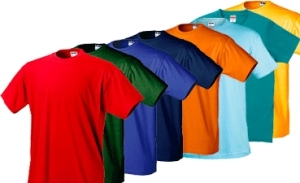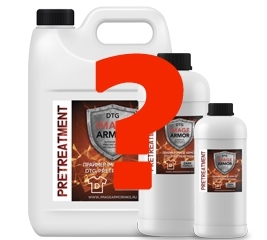

In this article, we will consider the issue of a textile primer. The very concept of primer or from English – preptreatment – means preparation before some kind of action. Very often you can find the term primer in construction, painting, etc. The primer is used to prepare the surface for further processing. So before painting, a primer is applied so that the primer or paint clings to the surface more firmly and closes the micropores. Similarly in construction – preparation before applying various solutions.
In direct printing on textiles, a primer is also used. But first, let’s remember how the technology of direct printing on fabric works.
Special ink – textile ink – is applied to fabric fibers using inkjet printing. When hit on them, the ink is absorbed and, thereby, stains the fibers from the inside. This explains the high resistance to washing, wear, deformation of the printed pattern on the fabric, because in fact the pattern is nothing more than a dyed fabric, only not at the factory, but in the printer. Of course, the important point is the quality of the ink. We recommend using the textile inks that we have on our website. We work with these inks ourselves and have a great experience of using them. Catalog link: textile ink.
However, back to our question. It can be seen from the technology that the fabric is dyed from the inside. But there is one point. Color enough on the top layer, the front one, so that the pattern can be seen. It’s a question of economy. If you apply a large amount of ink, the fabric will be soaked through. This is good, very durable, but very uneconomical. Therefore, a certain balance is found in order to save textile ink, and print durability is not affected. By the way, how responsibly they print on T-shirts can be determined by the amount of ink.
In practice, there are two options for printing. The first is printing with a high ink supply so that the material is already wet. Naturally, the consumption of ink increases. And the second option is printing in two passes. In this case, you need quality equipment, such as MPrint textile printers. The layer-to-layer hit on repeated passes is 100%. Printing in two passes is good because the feed is small, and after the first pass the fabric is dyed and dries. The second pass saturates the picture.
With a two-pass system, the saturation is higher, but the time is longer.
We talked about printing on white T-shirts and fabrics. If you need to print on dark ones, then a white substrate is applied and printed on it in one pass in color.
And now, what happens when the first pass is white? That’s right, white ink digs into the fabric, “falls” into it and bright, saturated white will not work, which means that the color pattern will be pale.
This is where a primer is needed. It is simply necessary here. After treatment with a textile primer, the surface of the fabric, the T-shirt becomes “sticky” and the white ink no longer impregnates the fibers like that, but remains at the top. As a result, we get a rich print.
Similarly, a textile primer can also be used on white fabrics. In this case, one pass will be enough when printing, because the ink will not “fall through”. Printing with a primer produces a richer color.
For these purposes, there are two types of textile primers: for dark and for light fabrics. The thing is that the primer on black will leave marks on white when it dries. We have 2 types of primers in the catalog. Look.
Now consider the issue of applying a textile primer to T-shirts or fabric. Most small and beginner print studios use an air blower or even a manual airbrush. Of course, you can apply the solution in this way, but there are several bad points.
Firstly, when using such methods, the uniformity of applying the solution over the entire area will leave much to be desired. Of course, you can practice, but… From here it follows that the consumption of the primer will be greater than by automated methods, and also, the uneven application on the T-shirt is also not strong, but it will affect the quality of the print.
Secondly, when using open spraying, humidity will increase in the room, the primer vapors are not toxic, but the room should be well ventilated, because it will not seem like a shift to work with it. Increased humidity will affect everything around, i.e. as a conclusion – you need a separate room for priming, or a zone, but then the operator will have to run from the booth (room) to another room, where there is a heat press and a printer. High humidity adversely affects equipment, printers. Liquids must not be sprayed near them.
Thirdly, due to its composition, the primer is sticky and slightly aggressive to iron. Those. spraying in an open way, the surrounding objects will be covered with a sticky solution. This will attract dust. And spraying near the printer is prohibited at all, because if it hits the print head, the printing process will be interrupted until the head is washed off the primer.
Summarizing the above, we can conclude that machine application in a closed volume is needed. And we have such cameras for priming. They help with large volumes, help keep the workplace clean, help save primer.
So, answering questions, a primer is needed, but for dark ones it is mandatory. The primer is for dark and light fabrics, you can not confuse and replace one with another. It must be applied by machine.
Only by adhering to these simple answers-recommendations can you get high quality printing, and the client will always be satisfied and ask to print another print.
That’s all. All bright and juicy prints without marriage and downtime!